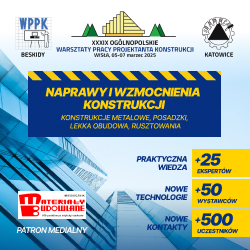dr inż. Wojciech Węgrzyński, Instytut Techniki Budowlanej, Zakład Badań Ogniowych
dr inż. Grzegorz Krajewski, Instytut Techniki Budowlanej, Zakład Badań Ogniowych
MSc. Eng Gabriele Vigne, University of Jaén, Fluid Mechanics Department, Spain
Autor do korespondencji e-mail: Ten adres pocztowy jest chroniony przed spamowaniem. Aby go zobaczyć, konieczne jest włączenie w przeglądarce obsługi JavaScript.
DOI: 10.15199/33.2017.08.14
W artykule przedstawiono metodę szacowania widzialności w dymie wykorzystywaną jako element numerycznego modelowania skutków pożaru w obiektach budowlanych.
Metoda ta powstała w latach siedemdziesiątych w Japonii jako uzupełnienie prostych matematycznych modeli pożaru i w niemal niezmienionej formie została zaadaptowana do nowoczesnych narzędzi inżynierskich. Jej ograniczeniem są przede wszystkim niedoskonałości matematycznego modelu osłabienia natężenia światła w dymie na podstawie prawa Lamberta-Beera oraz podatność na dane wejściowe podane przez użytkownika, w tym w szczególności tzw. współczynnika generacji sadzy (soot yield, Ysoot). Artykuł jest podsumowaniem pracy autorów w tej dziedzinie, ma na celu zwrócenie uwagi projektantów na możliwe źródła błędu w metodzie CFD.
Słowa kluczowe: dym, widzialność, pożar, CFD.
* * *
Estimation of the visibility in smoke – practical aspects
The paper treats on the method of evaluating visibility in smoke, used as an element of numerical modelling of the effects of fire within buildings. This method was developed in Japan in 70’s as element of simplified fire models, and nowadays it is implemented in an almost untouched form in modern tools. The limitations of the method come from the uncertainty of the Lambert-Beer law, as well as its vulnerability of the user input (especially the soot yield parameter). This paper is a summary of the authors work in this field, and the aim of it is to increase the consciousness of the designers on the possible source of error, in the CFD method.
Keywords: smoke, visibility, fire, CFD
Literatura
[1] ANSYS. 2014. ANSYS Fluent 14.5.0 – Technical Documentation.
[2] Ayala P., A. Cantizano, C. Gutiérrez-Montes, G. Rein. 2013. „Influence of atrium roof geometries on the numerical predictions of fire tests under natural ventilation conditions”. Energy and Buildings, Elsevier B. V.65:382 – 390. DOI: 10.1016/j.enbuild.2013.06.010.
[3] Janssens M., J. Huczek, K. Onaka, S. Turner. 2016. „Use of FDS to Comply with Performance-Based Requirements Based on Smoke Layer Height”. 11th Conference on Performance-Based Codes and Fire Safety Design Methods. SFPE. Warszawa.
[4] Jin T. 2002. „Visibility and Human Behavior in Fire Smoke”. SFPE Handbook of Fire Protection Engineering, 3rd Edition: p. 2-42-2–53.
[5] Jin T. 1970. „Visibility through Fire Smoke (I)”. Bulletin of the Fire Prevention Society of Japan 19.
[6] Jin T. 1971. „Visibility through Fire Smoke (II)”. Bulletin of the Fire Prevention Society of Japan 21.
[7] Konecki M., M. Półka. 2010. „Calculation of visibility in smoke generated during thermal decomposition and combustion of polyester materials”. Modern Building Materials, Structures and Techniques, MBMST 2010, Vilnius.
[8] McGrattan K., S. Hostikka, R. McDermott, J. Floyd, C. Weinschenk, K. Overholt. 2015. Sixth Edition Fire Dynamics Simulator Technical Reference Guide Volume 1: Validation guide. DOI: 10.6028/NIST.SP.1018-1.
[9] McGrattan K., S. Hostikka, R. McDermott, J. Floyd, C. Weinschenk, K. Overholt. 2016. Fire Dynamics Simulator User’s Guide, Sixth Edition. DOI: 10.6028/NIST.SP.1019.
[10] McGrattan K., S. Miles. 2016. Modeling Fires Using Computational Fluid Dynamics (CFD). SFPE Handbook of Fire Protection Engineering. New York. Springer: 1034 – 1065. DOI: 10.1007/978-1-4939-2565-0_32.
[11] Mulholland G. W. (2008) Smoke Production and Properties. SFPE Handbook of Fire Protection Engineering. Fourth Edi. NFPA & SFPE, Quincy, MA.
[12] Mulholland G., C. Croarkin. 2000. „Specific extinction coefficient of flame generated smoke”. Fire and Materials 24: 227 – 30. DOI: 10.1002/1099-1018 (200009/10) 24: 5<227: AID-FAM742>3.0. CO; 2-9.
[13] Nelson H. E., F. W. Mowrer. 2002. Emergency movement. SFPE Handbook of Fire Protection Engineering. Third Edition. NFPA & SFPE. p.: 3-367-3–380.
[14] Rasbash D. J., D. D. Drysdale. 1982. Fundamentals of smoke production. Fire Safety Journal 5: 77 – 86. DOI: 10.1016/0379-7112 (82) 90008-X.
[15] Vigne Gabriele. 2015. „To what extent can we rely upon the results obtained from advanced smoke modelling”. SFPE Copenhagen.
[16] Vigne Gabriele, Wojciech Węgrzyński. 2016. „Influence of Variability of Soot Yield Parameter in Assessing the Safe Evacuation Conditions inAdvanced Modeling Analysis. Results of Physical and Numerical Modeling Comparison”. 11th Conference on Performance-Based Codes and Fire Safety Design Methods, SFPE.
[17] Vigne Gabriele, Wojciech Węgrzyński. 2016. „Experimental And Numerical Analysis Of The Influence Of The Soot Yield When Conducting Cfd Analysis For The Estimation Of The Available Safe Evacuation Time”. Interflam 2016.
[18] WęgrzyńskiWojciech, Grzegorz Krajewski, P. Suchy. 2015. „Zmienność cech materiałowych a szacowany zasięg widzialności w analizach CFD”. Sprawozdanie Roczne – NP-105. Instytut Techniki Budowlanej.
[19] Węgrzyński Wojciech, Gabriele Vigne. 2017. „Experimental and Numerical Evaluation of the Influence of the Soot Yield on the Visibility in Smoke in CFD Analysis”. Fire Safety Journal (in Press). DOI: 10.1016/j.firesaf.2017.03.053.
[20] Widmann J. F. 2003. „Evaluation of the planck mean absorption coefficients for radiation transport through smoke”. Combustion Science and Technology 175: 2299 – 2308. DOI: 10.1080/714923279.
[21] YamadaY.,Y.Akizuki. 2016. „Visibility and Human Behavior in Fire Smoke.” SFPE Handbook of Fire Protection Engineering. New York. Springer New York: 2181 – 206. DOI: 10.1007/978-1-4939-2565-0_61.
Otrzymano: 20.06.2017 r.
Materiały Budowlane 8/2017, str. 46-48 (spis treści >>)




























